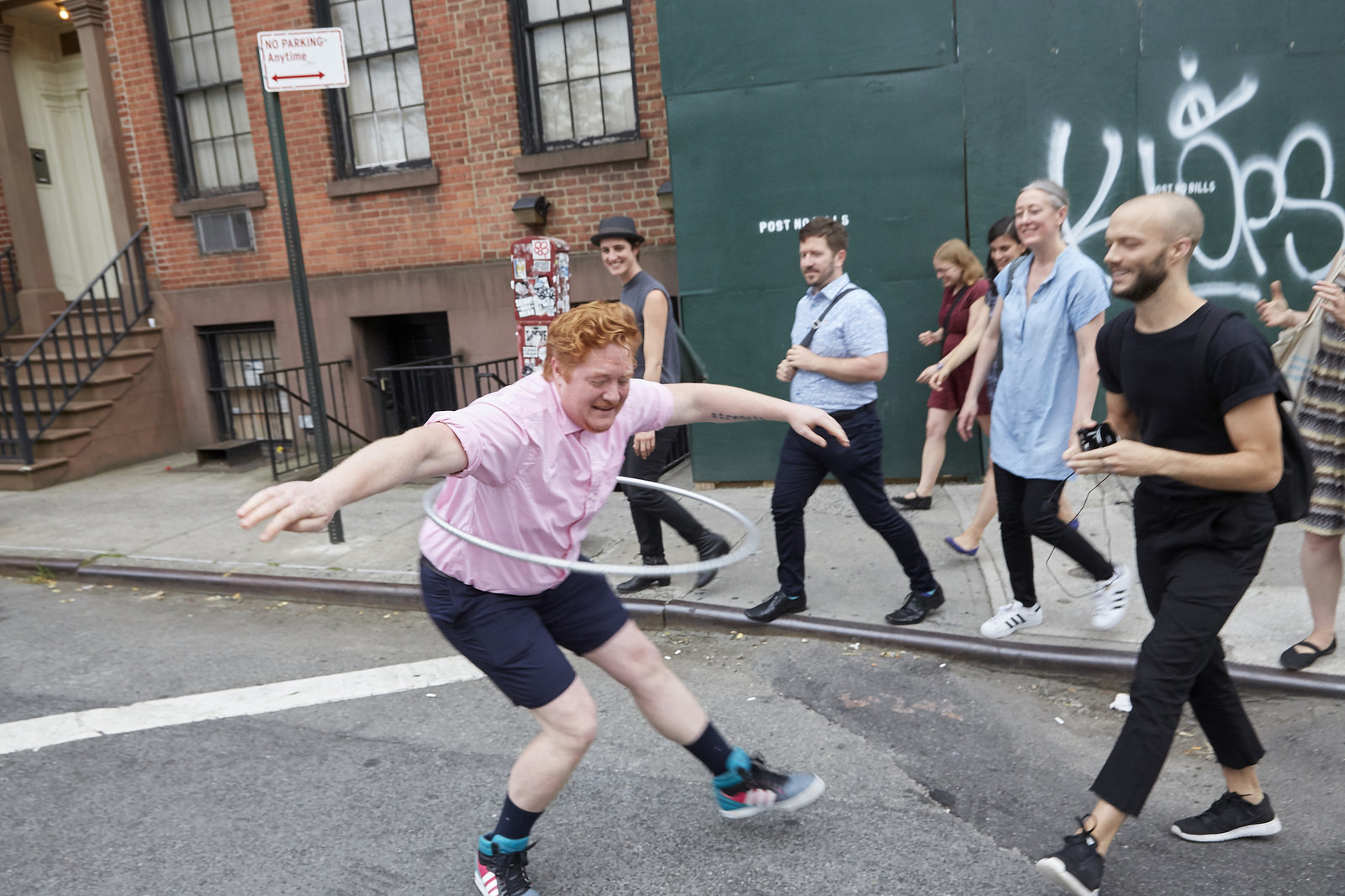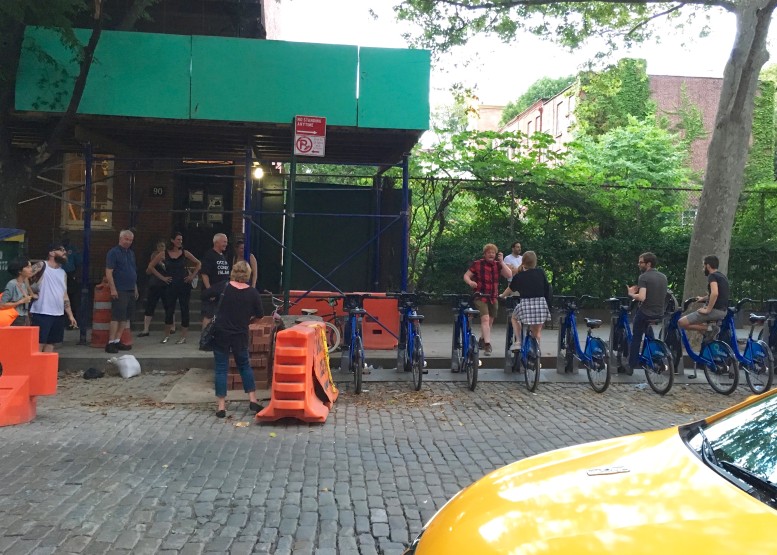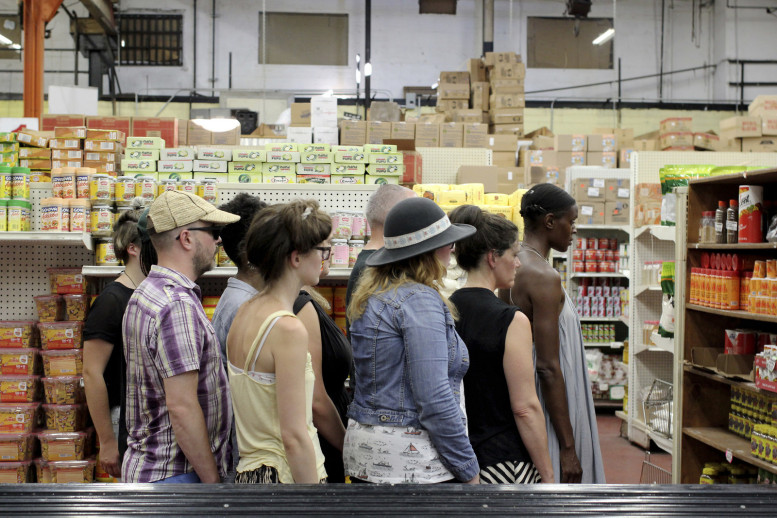Two-Part Names & Other Joys: An Interview with Faith Zamblé
The Civilians' Resident Dramaturg Phoebe Corde sits down (virtually) with Extended Play editor Faith Zamblé to talk dramaturgy, research, and more.
Sign up to get spam-free email updates to ensure you never miss an article and to receive exclusive details about performances and events from The Civilians.
 Becca Blackewell shows off their hooping skills on the Elastic City walk, "This is My Worst Nightmare." Photo Credit: Eric McNatt
Becca Blackewell shows off their hooping skills on the Elastic City walk, "This is My Worst Nightmare." Photo Credit: Eric McNattI arrive sweating in 90 degree July heat at Grand Army Plaza in Brooklyn and join a group of 10 to 12 participants. Like frozen statues, Todd Shalom and Niegel Smith greet us. Breaking their tableau, the duo gives instructions — or prompts, as Shalom calls them — to imagine something to memorialize. I choose to honor a lost friendship. They then prompt us to select a partner to “sculpt” into our chosen memorial.
The guy next to me smiles awkwardly as we default to our nearest neighbors for partnership. He tells me he did a walk several years ago and believes he may have sculpted someone into a monument then, too. That’s entirely possible because “The Last Walk” was comprised of prompts from various artists throughout the seven-year run of the Elastic City festival, a cornucopia of public walks offered by sundry artists from diverse disciplines.
In my conversation last year with Todd Shalom, artistic director of Elastic City, he spoke about discovering “beautiful, unexpected, serendipitous moments” throughout the walks he curates.
This year, I had the pleasure of going on not one, but three Elastic City walks. The walks were “Market Thrum” created by Okwui Okpokwasili, a writer, choreographer, and performer; “This is My Worst Nightmare” by Becca Blackwell, an actor, performer, and writer; and “The Last Walk” (The title is a riff on The Band’s “The Last Waltz”) guided by Shalom, himself, and Niegel Smith, longtime collaborator and artistic director of the Flea.
During the three walks, I definitely experience unexpected, serendipitous beauty. If you only went on one walk, you wouldn’t be able to describe what Elastic City is. You’d be able to share the experience of that walk, but the overall festival is so varied as to not offer the same experience ever again. Even when a new artist recreates the prompt of an originator, the experience isn’t the same. Which is maybe why Todd Shalom is keen to make a book about all these experiences. It’s like a cookbook for public art.
You also quickly learn what is acceptable and not acceptable behavior. It’s okay to run wildly through an open field in Prospect Park with a group of people following you, screaming and gyrating your bodies. It’s less acceptable to walk extremely slowly with a group of primarily white people through an African Market in the Bronx.
THE INTERSECTION OF CHANCE & CHANGE

Becca Blackwell directs the participants on “My Worst Nightmare” to recreate a crowd scene from the West Village in the early 90’s. Photo Credit: James Carter
According to their bio, Becca Blackwell is a “New York City-based trans actor, performer, and writer. Existing between genders, and preferring the pronoun ‘they,’ Blackwell works collaboratively with playwrights and directors to expand our sense of personhood and the body through performance.”
Blackwell has a way of making you feel instantly comfortable. As I arrive, Blackwell dole out big hugs. They smile warmly at each of their guests on the walk as they share a story of their early years in New York City.
1993: the marys, queers, trans, and lesbians were still the heart of the West Village. Blackwell starts her walk in front of a construction site. They tell us they use to work here as a bartender back in the day. It once was Crazy Nanny’s, one of several true blue lesbian bars in NYC. Now, it’s been shuttered to make way for a doggie day spa. Gentrification marches on.
Blackwell encourages their newfound crew to shout at the West Village streets epitaphs to time gone by. “There didn’t use to be strollers in the West Village!” I holler. Everyone laughs except for the young mother pushing her baby down the sidewalk.
Outside a sex shop, Blackwell dares a participant to literally slap them in the face and purchase a sex toy inside the store, recounting their once frequent blackouts and random sex toy purchases, all reenacted with the audience.
Sometimes in the role of Blackwell, sometimes in the role of a hustler, a yuppie, or neighborhood gawkers, the audience helps recreate the world Blackwell once knew. One stop recreated where Blackwell hula hooped topless for cash in the street and graduated to hooping at parties for the Village Voice.
Throughout Blackwell’s walk down memory lane, wistfulness and full on terror convey the message that gone are the safe places for LGBTQ to congregate in the West Village. Sure, there are gay bars and clubs in NYC, but fewer every year in the West Village, the birthplace of the gay rights movement.
One of the most poignant moments of the evening was when Blackwell mock auditioned an audience member with a monologue from “Who’s Afraid of Virginia Woolf?” After the audition, Blackwell awarded the part to a woman in the group. Blackwell informed her she would be taking over for Estelle Parsons in Israel Horowitz’s “Out of the Mouths of Babes.” Blackwell even wrote up a notice for the poster outside the Cherry Lane Theater.
Then, another audience member — who happened to know Ms. Parsons — told Blackwell that Ms. Parsons had actually collapsed onstage a couple days earlier, and the producers were forced to close the play. Surprised and embarrassed about the news, Blackwell apologized to the group. Blackwell’s tongue-in-cheek humor is matched only by their sensitivity. Afterward, Shalom shared with me that Blackwell personally contacted and sent well wishes to Ms. Parsons through the audience member acquainted with her.
It was a tender coincidence that amplified the message of Change and Chance, intersecting streets in the West Village.
We ended the walk at Henrietta Hudson’s, the last lesbian-only owned and operated bar in the United States. It felt like we were standing our ground, preventing it from becoming another doggie day spa.
SPACE INVADERS

Okwui Okpokwasili slowly leads her “Market Thrum” through Gold Coast Trading Company. Photo Credit: Santos Muñoz
“It a people market!” a woman shouted as nine of us slowly followed Okwui Okpokwasili through Gold Coast Trading Company in the south Bronx.
She was telling us this wasn’t our market. It is a place where Africans shop, gather, and commune. It wasn’t our place to create art. One of our participants — an African American woman — tried to explain our mission. The woman disappeared and left us to our ritual.
Walls of Bounty, Ajax, Goya, and West African spices hovered over us as we weaved our way through the market’s maze. Prior to entering the market, Okpokwasili explained women would cleanse the roads to the market, and we were symbolically going to do the same at Gold Coast Trading Company. At a walking meditation pace, we moved together as much as a unit as we possibly could contain.
But what if a space and its owners do not want the roads to their market cleansed? What if they have a special place in their neighborhood in which Americans do not visit? As participants, we became performers for people who didn’t want a performance. They were confused, concerned. But we never felt unsafe.
One man, in a green cap with a red star, stopped and stared. He grinned, seemingly getting it, turned around, and headed down another isle.
But to other customers and employees, the ritual seemed sinister. Maybe it was a ceremony to bring bad juju. That’s what the market’s owner suggested to Okpokwasili after the walk as we stood outside and waited for her to finish negotiating with him.
Shalom said someone told him, “This is an African market. Not an American market.”
Outsider. Infiltrator. Other. For a change, I was placed in the uncomfortable position of feeling unwelcome.
Okpokwasili grew up in this neighborhood, and she wanted to share something from her childhood. The smells, the energy, the malts, and chin chin awakened a childlike joy in her. All she wanted to do was share a special experience in a special place with a small special group of people.
In the end, Elastic City decided it best not to return to the market and disturb them again. The remainder of Okpokwasili’s walks trekked through the Harlem Market.
THAT’S ALL, FOLKS!

Todd Shalom, far left, and Niegel Smith, far right, lead “The Final Walk” participants as they sing “Tomorrow” from the movie musical “Annie.” Photo Credit: Santos Muñoz
As for Todd Shalom, he feels satisfied with seven years.
“I feel like we’ve fulfilled our mission,” says Shalom. “Over the past seven years, we’ve potentially expanded the way in which thousands of people experience their everyday. I’ve never wanted Elastic City to institutionalize in a way where we’re beholden to anyone — I see it like a small record label or an indie press— it’s always been a project with a focus to produce rigorous work and get it out there directly to the public.”
The next step is a book. A manual of sorts that will detail prompts from previous artists’ walks. Shalom will also offer best practices for artists and enthusiasts who wish to work in the participatory walk form.
“Outside of one’s experience on a walk,” says Shalom, “this is how the project can live on.”
In the meantime, Shalom plans to continue teaching in the MFA in Writing program at Pratt Institute and travel a bit.
“Certainly, I’ll continue to work with Niegel Smith on Willing Participant and other participatory performance work,” Shalom says. “I’ll also continue to give walks for friends and as commissioned. Long-term, I imagine that I’ll start something new, potentially around social justice and participatory art.”
Like all things in life, Elastic City was ephemeral. But the feelings and memories allow it to live on. And if the participants ever return to these locations, they might think, “Hey, this is the spot where I belted ‘Tomorrow’ from the 1984 movie musical hit ‘Annie’ with 10 strangers after we crawled on our hands and knees through Grand Army Plaza. That was a once-in-a-lifetime experience.”